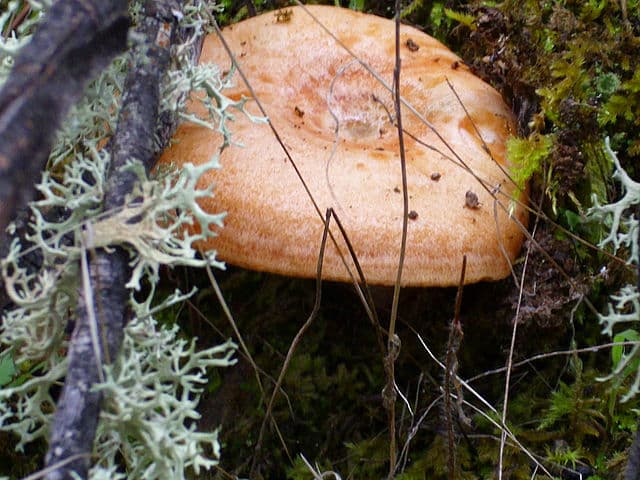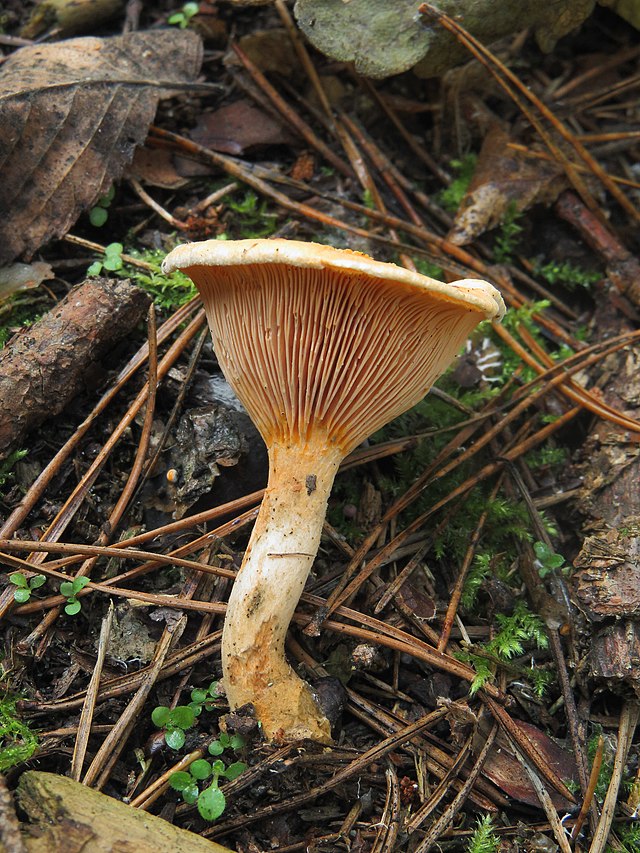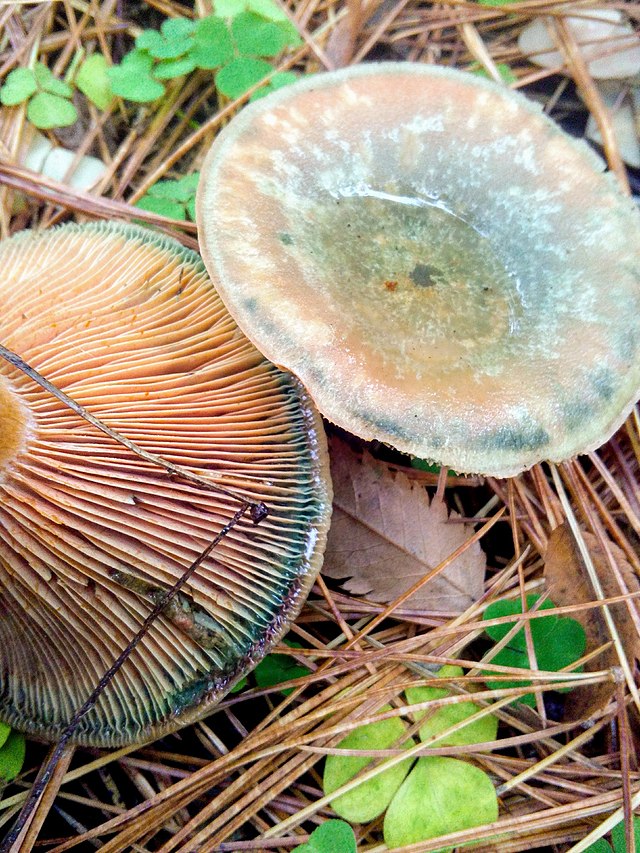
Walking among the shore pines along the Washington coast in fall is likely to yield my favorite edible mushroom: the saffron milk cap (Lactarius deliciosus). This bright orange mushroom has a depression in the center of the cap, and the edges roll under. Some specimens may begin to take on a bit of a greenish tint on the top half of the cap, but the gills often remain brilliant–almost fluorescent–orange, or a pink to salmon hue. Sometimes the cap appears to have concentric circles of different shades of orange emanating out from the center. The stipe is white with pink or salmon shading, often with a spotted or pitted texture.
The mushroom doesn’t usually get more than about four to five inches across in the largest specimens, and it has nice, firm flesh that may stain green when damaged. This is due to a reddish milky substance that these mushrooms exude when broken or cut, and which turns green when dry.
Saffron milk caps have a mycorrhizal relationship with several species of conifer, particularly pines; in fact, one of its other common names is the red pine mushroom. In the United States it is commonly found along the west coast and east of the Great Plains, as well as scattered throughout the Rocky Mountains. Its orange color makes it easy to spot in the underbrush, though greener specimens may be a little better camouflaged. It may begin fruiting in July, though the peak is in October to November, after which it drops off sharply.
Lookalikes
Saffron milk caps are not the only orange mushroom growing on the forest floor. Darker colored golden chanterelles may look similar at a glance, though these edible mushrooms have false gills, which are thicker and more widely spaced than the milk cap’s true gills. Lobster mushrooms, another edible, also sometimes have a similar orange color, but they are often larger and have a more irregular shape and crusty surface.
Be careful not to pick false chanterelles, which are often mycorrhizal with the same trees as milk caps, and have similar coloration, gills, and a rolled-under edge to the cap. If you look closely at a false chanterelle, there is a fine fuzz or down on the surface of the cap. It also does not exude “milk” or stain green. False chanterelles have a white spore print, whereas the saffron milk cap is tan.
Finally, avoid jack o’lantern mushrooms; these are similarly orange, but they grow out of rotting wood rather than the soil. They also have thinner, more delicate flesh, and may grow in clusters, while the saffron milk cap grows as individual mushrooms.

Is it Really Delicious?
In Europe the saffron milk cap is considered a highly prized delicacy, while in North America it may be disdained as being too “mild”. There is speculation that there are different varieties of L. deliciosus in Europe, eastern North America, and western North America, and that the flavor profile may not be the same in all three.
Be aware that the occasional specimen may have a slightly bitter taste, though this often goes away after cooking (don’t eat them raw!) You can soak them in water for 30 minutes before cooking to reduce the chance of bitterness.
I personally find them very tasty, and I appreciate that they hold their texture well when cooked. My favorite dish is simply sauteeing them in butter or olive oil, sometimes on their own and sometimes over pasta. However, they lend themselves well to a variety of mushroom-based dishes. As with other wild mushrooms, if this is your first time eating saffron milk cap, try a small amount (thoroughly cooked) first to make sure you don’t have any sensitivities to this species.

—————
Written by Rebecca Lexa
Rebecca Lexa is a certified Master Naturalist in the Pacific Northwest. She teaches classes on foraging and other natural history topics, both online and off. More about her work can be found at http://www.rebeccalexa.com.
Many of our readers find that subscribing to Eat The Planet is the best way to make sure they don't miss any of our valuable information about wild edibles.
See our privacy policy for more information about ads on this site






